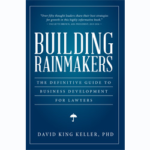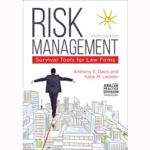The San Francisco Law Library maintains a comprehensive Law Practice Management Collection, with publications that detail all aspects of running a practice—client relations, billing, marketing, finances, risk management, technology, and more. This post gathers together the newest additions to the Law Library’s LPM collection. Stay tuned for future installments that highlight the Law Library’s materials on additional LPM topics.
 Building Rainmakers: The Definitive Guide to Business Development for Lawyers, by David King Keller, PhD. American Bar Association, 2016.
Building Rainmakers: The Definitive Guide to Business Development for Lawyers, by David King Keller, PhD. American Bar Association, 2016.
If you only have time to read one book on business development, this exceptional new book should be the one. After all, the ABA’s Book Division anointed it the “most comprehensive and most collaborative ‘How-To’ book on business development techniques for lawyers ever published.” It gathers insights and wisdom from over 50 established business development professionals in short articles with an easy-to-read, conversational tone. But this book truly stands apart for its convenient organization. Each topic is presented alphabetically in the A to Z Business Development Guide, so simply scan the Index of Topic Titles and jump directly to those that you would like to read. This book also includes a chapter on how to avoid marketing disasters, as well as almost 30 exhibits that cover topics such as approaching potential clients, creating ideal target client lists, templates for business development plans, the sales process, and marketing and self-promotion.
 Every Relationship matters: Using the Power of Relationships to Transform Your Business, Your Firm, and Yourself, by Peter E. Rouse. American Bar Association, 2nd edition, 2016.
Every Relationship matters: Using the Power of Relationships to Transform Your Business, Your Firm, and Yourself, by Peter E. Rouse. American Bar Association, 2nd edition, 2016.
This stellar new edition packs an enormous amount of wisdom into its concise 149 pages. Author Peter E. Rouse surmises that every problem is at some level fundamentally a relationship problem. He delves into an exploration of how self-management and an understanding of the human condition can avoid problems and establish the foundation for strong relationships with clients and colleagues. The result is an indispensable guide on how to align personal and professional values to create a thriving law practice and a balanced life.
 A Lawyer’s Guide to Networking, by Susan R. Sneider. American Bar Association, 2nd edition, 2016.
A Lawyer’s Guide to Networking, by Susan R. Sneider. American Bar Association, 2nd edition, 2016.
In the adversarial world of legal practice, networking stands apart as a collaborative venture. Author Susan R. Sneider promptly dispels the tendency to dismiss networking as “lowbrow,” and instead shows how networking enhances community and mutual opportunity. This how-to guide leads readers through the rules of networking, how to overcome barriers, how to prepare for networking events, how to approach networking in the digital age, and more. If you’re seeking to uncover a new sense of satisfaction with law practice, while simultaneously boosting your business development prospects, the advice and tips in this book will help you do exactly that.
 Locked Down: Practical Information Security for Lawyers, by Sharon D. Nelson, David G. Ries, and John W. Simek. American Bar Association, Law Practice Division, 2nd edition, 2016.
Locked Down: Practical Information Security for Lawyers, by Sharon D. Nelson, David G. Ries, and John W. Simek. American Bar Association, Law Practice Division, 2nd edition, 2016.
We featured the first edition of Locked Down in October’s Law Firm Technology article, but the new second edition is now updated with the latest developments in information security. With ongoing reports of data breaches and rapid advancements in technology, our observations about the prior edition are as relevant as ever:
According to the ABA’s 2015 Legal Technology Survey Report, 15 percent of law firms of all sizes have experienced a security breach. Yet many firms continue to ignore that they are prime targets for hackers, despite multiple warnings from the FBI that they are exactly that. Locked Down tackles every aspect of a lawyer’s information security obligations, from backup solutions and data encryption, to disposal of confidential information and protecting yourself with cyberinsurance. With an understanding of how overwhelming and alarming this topic can be, this guide offers plenty of “war stories” to demand your attention, but then presents clear solutions on how to avoid them with a comprehensive information security plan.
 Risk Management: Survival Tools for Law Firms, by Anthony E. Davis and Katie M. Lachter. American Bar Association, Law Practice Division, 3rd edition, 2015.
Risk Management: Survival Tools for Law Firms, by Anthony E. Davis and Katie M. Lachter. American Bar Association, Law Practice Division, 3rd edition, 2015.
This management guide analyzes a law firm’s goal of achieving success from a specific angle: “it’s all about the culture.” The authors posit that it is practically impossible for a firm to thrive without having a culture where each person is free from the distraction of a law firm’s internal strife and tension. But how do you shape culture? This book explains how to do it by developing effective leadership, confronting problematic behavior, and creating a clear vision for the firm. It goes on to analyze marketing, lawyer recruitment, finances, and many more topics through the all-important lens of culture. The result is a thorough exploration of how to build a positive environment and ensure success for your firm. Risk Management was also included in December’s Management Essentials article.
 Virtual Law Practice: How to Deliver Legal Services Online, by Stephanie L. Kimbro. American Bar Association, Law Practice Division, 2nd edition, 2015.
Virtual Law Practice: How to Deliver Legal Services Online, by Stephanie L. Kimbro. American Bar Association, Law Practice Division, 2nd edition, 2015.
The first edition of Virtual Law Practice also appeared in October’s Law Firm Technology article. This new edition addresses the steady increase of consumers’ enthusiasm for online legal services and the relevant advancements in technology. Here’s what we had to say about the prior edition:
As consumers increasingly look to the internet to conduct their affairs and the demand for affordable legal services rises, virtual law practice is changing the nature of how lawyers and clients interact. Perhaps contrary to popular belief, virtual law practice is certainly not the purchase of a form contract with no review by a lawyer. Instead, delivering legal services via a secure online portal offers many benefits to both lawyers and their clients, and it requires a sophisticated understanding of technology, ethics rules, and other business considerations. This comprehensive guide covers how to structure your virtual practice, unbundling, practicing in multiple jurisdictions, choosing technology, billing, customer service, ethical implications, and much more. It includes case studies from successful virtual practitioners that will help you gain a competitive advantage during this fundamental transformation of the legal marketplace.
Andrea Woods is a Reference Librarian at the San Francisco Law Library.


